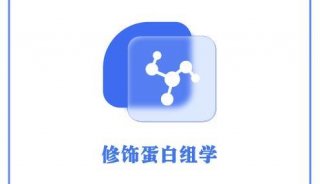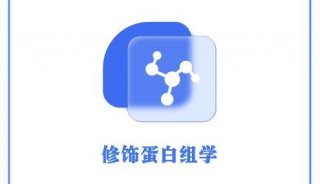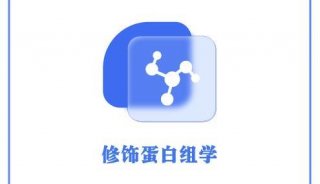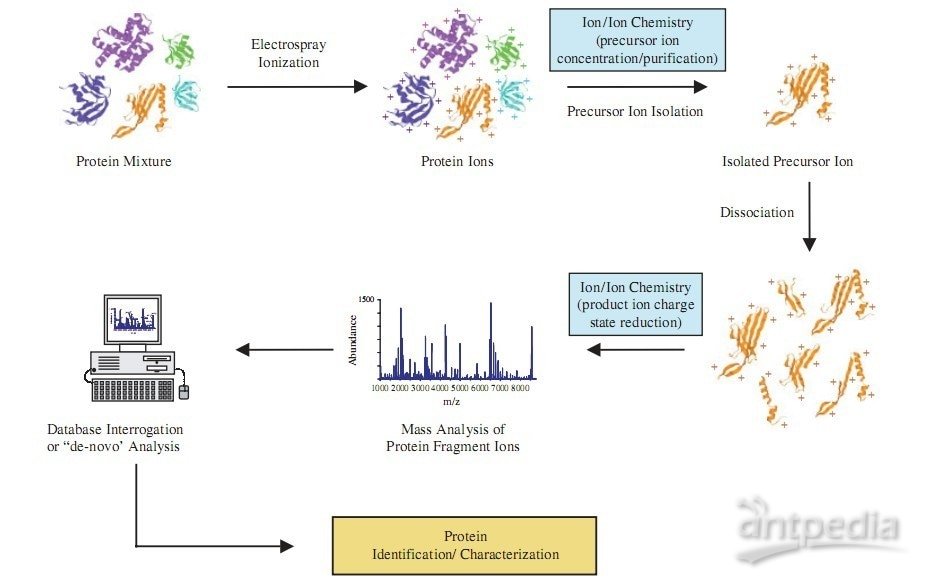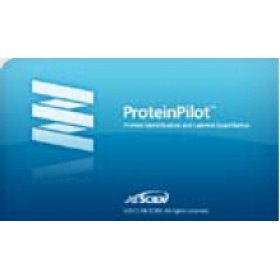蛋白组学实验中的常见问题及解答
1,关于使用三氯醋酸沉淀法后蛋白质难于重悬的问题
Q:1,Hi !I have been trying to clean and concentrate proteins form eucariotic cell culture medium in order to analyse them in 2D. I’ve read some papers were TCA precipitation was used and recommended for this purpose but I have not been able to redissolve my samples. I have used 10%TCA and let it precipitate for 30 minutes in Ice, afterwards I have centrifuge the sample, washed it with diethil ether and tried to dissolve the pellet in ordinary IEF sample solution containing Urea, Chaps, ampholites and DTT. I wasn’t able to dissolve the sample even using a 9M Urea concentration.
Do you have any suggestions on how to dissolve proteins from TCA precipitation or an alternative way to clean and concentrate proteins from culture medium for 2d analysis?
Thank you!
A:This problem occurs very often.
Better for cleaning and concentration of protein samples: Use the Ettan 2-D Cleanup Kit from Amersham Biosciences
点评:这个问题由AMERSHAM著名科学家回答,比较会替公司做广告.
其实真核细胞总蛋白质的提取用不着使用TCA/acetone法,细胞相对于植物组织还是比较干净的,少掉了一些脂类\酚类杂质.对于组织来讲,使用clean-up kit效果还是不错的
2.在第二向电泳中,为什么我的溴氛蓝条带都跑到玻璃板下缘了而蛋白质只跑了一半啊,郁闷!
Q:Can anyone help with a recent problem with proteins only running half way despite the running dye reaching the end. This problem has suddenly appeared, running buffer is new batch but has been pH'd and made to the same recipe as before. Gels are 10%T being run under the same conditions as always (70V overnight at RT). Not only do the proteins on the gel seem to disappear towards the bottom half but the molecular weight markers also become very faint and blurry. It almost looks as if the low Mw proteins have somehow diffused out of the gel, although this does not seem possible. I know that I cannot expect low Mw proteins to focus as sharply as high, however they have never been this fuzzy before.
Thanks
A:Never "pH" the running buffer!! In this way you have introduced Cl- Ions into the Tris-glycine buffer: this is a No-No. The system has to move all Cl-ions out of the cathodal buffer tank before glycine and proteins start to migrate. When you make your running buffer, just use Tris, glycine and SDS of good quality, according to the stsndard recipe. You do not need to measure the pH; and you must not titrate the running buffer!
点评:兄弟们知道这个同志犯了什么低级错误吗,他老人家自做聪明使用HCL去调Tris-Glysin running buffer的PH值,危害是电泳系统在开始迁移甘氨酸和蛋白质之前必须把阴极的CL离子都跑出去,结果自然就造成了蛋白质斑点迁移的滞后了,呵呵.
关于Destreak reagent的原理和使用
Q:Why is it not necessary to use a reducing agent such as DTT when samples are being subjected to isoelectric focusing with the destreak reagent? I am just concerned that if disulfide bonds are present in the protein mixture, the destreak reagent itself will not be able to reduce them. It seems that it would be important to add DDT.
A1: Destreak is a reductant and a disulfide. It is actually hydroxyethyl disulfide or HED. It is very similiar to another popular reductant, 2-mercaptoethanol; HED is basically what 2-ME would be if it formed a disulfide bond with another 2-ME molecule. Having too much DTT around will break the disulfide bonds made with HED. The big benefit of DeStreak (HED) is that when it is in a disulfide bond it is essentially non-ionizable where as DTT still has an ionizable group in the form of the other thiol group. (I would not recommend using 2-ME as a reductant as it is usually badly contaminated with impurities)
A2:You extract your sample with a reductant, like DTT. This reduces the disulfide bonds. This sample is loaded via cup-loading at the anodal side on the IPG strip, which was pre-rehydrated with urea, thiourea, detergent, IPG buffer and DeStreak
点评: DeStreak (HED)试剂是一种新型的还原剂,非常近似于2-巯基乙醇.在上样缓冲液中加入DTT过多(通常是超过10mM)会严重干扰DeStreak (HED)的还原效果.因此,建议使用DeStreak (HED)时最好采取上样杯加样,提取样品时仍使用DTT,而使用DeStreak (HED)进行IPG胶条的泡涨.这样,最终的DTT浓度稀释到了10mM以下.
怎样保存2-D凝胶?
Q: I want to keep 2-D gels for analyze it latter, with out the risk of damaging proteins quality and/or gel freezing. Is DDH2O with 20% Glycerol in -20oc is o.k.?
Thanks
A1: Don't freeze the gel. Store it at 4C in a plastic bag. I would also make sure that you soak the gel in something with about 10% ethanol so you don't get microbial growth. A 20% glycerol solution is a very good growth medium.
A2: Even if you later decide very much later that you want a peptide mass fingerprint from the dried gel it can be done. I returned to a gel that I had left dried in an old lab book for 8 years. Once we had a Maldi-tof MS and a genome project had rolled by I was able to return to an ancient band that was all that was left of my tediously purified protein and find its gene from its peptide mass fingerprint. (See Insect Biochem. Mol. Biol. 31 (6-7): 513-520, 2001.)
点评:2-D凝胶通常在4度保存,置于密封之塑料袋中,可以加入10%的乙醇(小弟自己保存在1%的冰乙酸中,4度,一般放2周-1个月没什么问题,虽然文献报道可以放更久,但是心里有点怕,故未作冒险尝试![]()
![]()
![]() ),最好不要单独使用20%的甘油,这个东东乃是细菌的良好培养基
),最好不要单独使用20%的甘油,这个东东乃是细菌的良好培养基
后面第二个牛人做完干胶后放了八年!太恐怖了!八年前质谱还不够成熟,此外尚无完整的基因组数据,所以这个牛人八年后才做的肽指纹图谱,NB吧!
二维电泳图谱的扭曲
Q:Hello!
I've been running 2D gels for over a year now. Most of the time my gels look good or OK, except for the spots in the acidic area. These spots are not very well resolved and give me smear. Occasionally I also get vertical distortions on my gel which I attribute to an air bubble trapped between the strip and the gel. I use Amersham's 12.5% gels and Ettan DALTtwelve apparatus. I work with rat liver nuclear extracts that I prepare for IEF using Amerasham's PlusOne 2-D CleanUp kit. Gels are stained with SYPRO Ruby.
Last week I ran 3 gels simultaniously. Two of the gels looked good, although the third gel, in addition to the usual streaks in the acidic area, had an ugly-looking basic area (right part of the image attached). After the IEF, the strip was normal in appearance, so I believe that the problem originated during the second dimension run. What could cause the basic area look so distorted? I want to avoid this problem in the future.
Thank you for any suggestions.
A:My guess: the lower edge of the gel was not completely flush with the glass plate edge of the support cassette. The gel edge, not the film edge, should be flush with the glass plate edge
二维电泳图谱的扭曲
Q:Hello!
I've been running 2D gels for over a year now. Most of the time my gels look good or OK, except for the spots in the acidic area. These spots are not very well resolved and give me smear. Occasionally I also get vertical distortions on my gel which I attribute to an air bubble trapped between the strip and the gel. I use Amersham's 12.5% gels and Ettan DALTtwelve apparatus. I work with rat liver nuclear extracts that I prepare for IEF using Amerasham's PlusOne 2-D CleanUp kit. Gels are stained with SYPRO Ruby.
Last week I ran 3 gels simultaniously. Two of the gels looked good, although the third gel, in addition to the usual streaks in the acidic area, had an ugly-looking basic area (right part of the image attached). After the IEF, the strip was normal in appearance, so I believe that the problem originated during the second dimension run. What could cause the basic area look so distorted? I want to avoid this problem in the future.
Thank you for any suggestions.
A:My guess: the lower edge of the gel was not completely flush with the glass plate edge of the support cassette. The gel edge, not the film edge, should be flush with the glass plate edge
偶师弟曾经问的一个问题,图比较菜,他刚开始做2-D电泳图谱,大家不要笑他喔, (其实也有老外做的东东简直是垃圾,我当时笑他们也好意思贴出来,然后著名科学家幽默地说您这次的图已经比以前贴出来的好得多了)
Q:my recent result below,give some advices ,please !!! the high background of the top area may partly due to not pouring the developing solution out through the lateral hole of the dying pot in time.why are there so many vertical stripes in the top area?
spot number is a little bit less, right?my loading sample is 100microgram, and proteins are detected by silver staining.
A1:The vertical stripes are coming from too short equilibration. equilibrate two times for 15 minutes, not 10 min.
A2:Furthermore: Start your second dimension with 2.5 W / gel for 40 minutes, not 5 W / gel for 30 min: it will give you a better separation quality.
他的电泳条件:sample lysis buffer:8M urea,4% CHAPS, 0.5%IPGbuffer, (v/w=3:1)
sample stored at -70degrees
rehydration buffer: 8M urea,2% CHAPS, 0.5%IPGbuffer,20mMDTT
IEF protocol: 30v 6h, 60v 8h, 200v 1h, 500v 1h, 1000v 1h,
1000~8000V gradient 30min,
8000v 60000vhrs. (IPGphor)
Equilibration: 2×10min, DTT, IAA
2nd electrophoresis: 400v/400mA/5w/gel 30min
400v/400mA/17w/gel 3hrs (Ettan-DALT six)
silver stain: Vorum protocol
点评:他平衡的时间不够,两步10分钟显然不够充分,SDS胶束尚未与蛋白质完全结合,可能也是纵条纹形成的原因之一.此外,好象AMERSHAM的电泳槽(尤其是ETTAN DALT SIX)推荐恒功率而BIO-RAD的电泳槽推荐恒流,不知大家有什么意见?
Q: I'm trying to use DTT(20mM) and TBP(2mM) simultaneously in my rehydration buffer,did they interfere with each other?Thanks in advance.
A: I wouldn't bother with TBP in the rehydration solution. It is good for lysis, etc., but it has a fairly short half-life so by the time rehydration is done and you are ready to focus the TBP is probably gone.
Q: So, you mean is better to use TBP only when you apply the sample after rehydratation? Only for IEF focusing?How can I manage with TBP, it is written on the Material Safety Data sheet ...spontaneously flammable in air....
A: When you do cup-loading, you should be underlaying the sample in an oil-filled cup so the sample won't evaporate and crystallize out. I would only use TBP in sample preparation/homogenization. (Yes, spontaneously flammable in the air would cause me concern too.)
点评:其实上面的那些帖子小弟实在不够资格点评,实在让大家见笑了.不过这一个确实需要点评一下:因为,这个问题是两年前小弟自己问的.我当时知道了三丁基磷酸的好处(还原效果远高于DTT,而且其最大的优点是其不带电,这样在等电聚焦过程中碱性端的TBP并不象带负电的DTT那样向正极移动,因此,碱性端保持着充足量的还原剂,蛋白质不会因还原剂不足而出现不同程度的氧化造成拖尾),决定采用,但又感情上抛弃不下DTT(惭愧ing),于是问这个著名科学家(sjouke hoving,想必做蛋白组学久一点的同行都有印象)是否能同时采用DTT和TBP,因为自己感觉多加还原剂效果应该更好啊,于是他建议说TBP是一种易自燃的物质,需要注意,并且建议仅在样品提取时用于还原作用,但泡涨时最好不用(因为泡涨时间太长而TBP半衰期很短),故偶在后来的7-10碱性胶条2-D电泳中均采用泡胀胶条后,cup-loading时再加TBP,结果跑出来的电泳效果非常不错.不是吹牛,碱性胶条的横向条纹较轻,比有些人跑的3-10的还强.
这个方法吐血推荐(因为经过自己的实践证明):希望用过cup-loading的兄弟一起探讨一下,咱们的双向电泳联会不要成为摆设.
PS:TBP用好了真不一定比AMERSHAM吹了半天NB的destreak差.而且平衡时可以简化步骤,一步平衡,还省iodoacetamide。如果做质谱,烷基化步骤可以放在酶切那一步。







